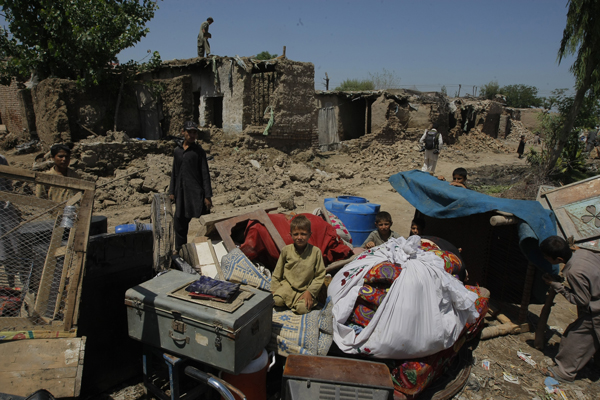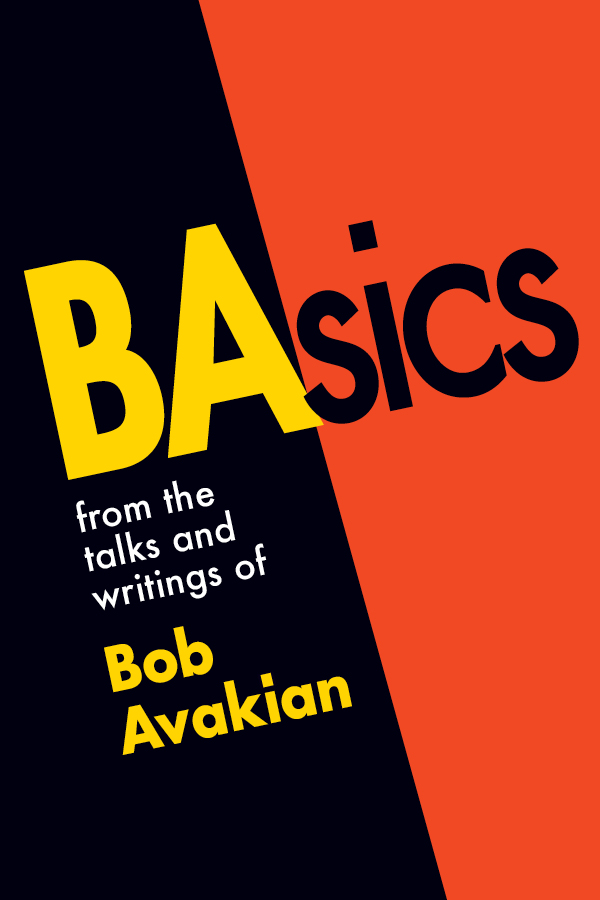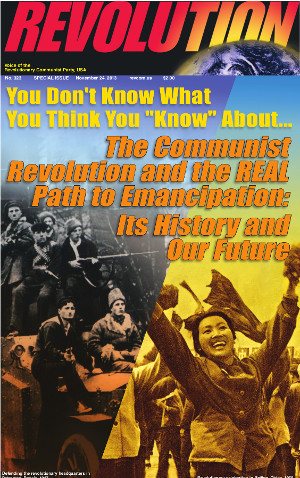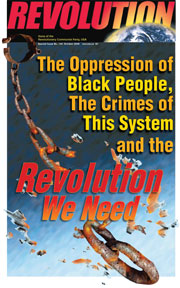From A World to Win News Service
Afghanistan: Three Decades of Mass Exodus
May 30, 2016 | Revolution Newspaper | revcom.us
May 23, 2016. A World to Win News Service. What became the “refugee crisis” in 2015—when it started to impact Europe—is not going to go away. How to handle its various aspects, mainly how to keep out refugees, continues to be a main point on the agenda whenever representatives of the imperialist powers get together. Who are these refugees, and why are they so desperate to get to Europe?

Afghanistan is an example of how imperialist interventions and occupations have destroyed the lives of millions. The country had the highest number of refugees in the world for 32 years in a row until last year, when another reactionary war fueled by the imperialists and other reactionary powers, each in pursuit of their particular interests, created even more refugees, this time from Syria. In fact, Afghan refugees at the present time constitute a quarter of all refugees worldwide. According to UN figures, 95 percent of them live in Iran and Pakistan. Above, a family of Afghan refugees who fled war in their homeland collect their belongings in Peshawar, Pakistan as refugee homes are demolished by government authorities. Many refugees face deportation back to Afghanistan. AP photo
Of the million or more who entered the European Union last year, after Syrians, who made up almost half, the second largest nationality group, about 180,000 people, were from Afghanistan.
Afghanistan is an example of how imperialist interventions and occupations have destroyed the lives of millions. The country had the highest number of refugees in the world for 32 years in a row until last year, when another reactionary war fuelled by the imperialists and other reactionary powers, each in pursuit of their particular interests, created even more refugees, this time from Syria. In fact, Afghan refugees at the present time constitute a quarter of all refugees worldwide. According to UN figures, 95 percent of them live in Iran and Pakistan.
What is different about the new wave of Afghan refugees is that many are better off, or at least have a house to mortgage and intellectual skills. There are reports they include many people with government jobs or in their last year of university studies in law, engineering and other professions. This shows there is no hope for the future among nearly all strata in Afghanistan, especially young people.
People trying to come to Europe from Afghanistan have to cross Iran and then go to Turkey, facing many hardships, including arrest, imprisonment and atrocities by the authorities and border guards. At a minimum, they have to pay large amounts in bribes. In many cases they have to pay traffickers as much as 3,000 or more U.S. dollars per person. Most do not have that much money, so they sell all the belongings they have gathered over their lifetime. There are reports that the number of second-hand shops in Kabul and other major cities in Afghanistan has tripled. So many people have had to sell or mortgage their homes that property prices have been brought down.
Most who cross into Europe from Turkey via the Greek islands travel in unsafe plastic or wooden boats. At least 800 people from Afghanistan were among the almost 4,000 who have died in the Aegean Sea.

The majority of Afghans who get to Europe are heading for Germany. Some 154,000 Afghan arrivals were registered in Germany in 2015. Chancellor Angela Merkel and German leaders at first wanted to take advantage of the situation and use refugees to revitalise some of the country’s dying villages and towns. But this opportunistic official welcome soon turned into hostility towards refugees, who were falsely accused of coming to “abuse” Germany’s welfare system and German people.
After the U.S. and its Western imperialist allies invaded Afghanistan in 2001, ousting the fundamentalist Taliban regime and installing the government headed by their hand-picked flunky Hamid Karzai, they promised to reconstruct the country and bring it stability and prosperity. But the people saw nothing but war, air raids, night raids, imprisonment, torture and a corrupt government of drug dealers and ex-jihadists backed by the Western countries. Along with poverty and unemployment came the return of poppy growing and soaring drug addiction. On top of that, the fundamentalist Taliban re-emerged as a powerful and constantly-expanding force. According to the latest statistics released by the UN’s Afghanistan mission, the number of civilians injured or killed last year was more than 11,000, the highest since the start of occupation. Even some U.S. officials, including National Intelligence director James Clapper, believe that “Afghanistan is at serious risk of a political breakdown during 2016.”
According to Afghanistan’s Independent Human Rights Commission, “violence and instability in 21 out of 34 provinces caused the displacement of more than 1.2 million Afghans in 2015.” Only a small fraction of them have been able to find their way into Europe. This disproves the argument that Afghans are leaving for Europe simply in search of a higher standard of living. The majority leave because they are forced to leave. Nearly a million Afghans have been displaced internally or gone to Iran and Pakistan. Some cannot go that far, and have to withstand the war, poverty, hunger, insecurity and brutalization by the Taliban, Daesh (IS) and government forces and the imperialist air strikes that even target patients, doctors and nurses in hospitals.
But the German and other Western European governments consider Afghanistan a safe country, or at least try to distinguish between refugees from areas they label safe and unsafe in Afghanistan. They pressure Afghan refugees to leave “voluntarily” by denying them asylum, and threaten to resort to force to send people back to a country that has been a battlefield in the contention between imperialists, and between imperialists and other reactionaries, for four decades.
The official number of Afghan refugees worldwide was 2.6 million even before the new wave of refugees in 2015. However the real number is estimated to be up to six million. There are about 1.5 million registered in Pakistan, and it is estimated that between half a million and a million more Afghans live there “illegally.” About 900,000 are registered in Iran, with up to two million living and working there “illegally.”
Prior to the mid-1980s, the number of Afghan migrants was not significant. However, after the Soviet occupation that was followed by the intervention of the U.S. and other Western powers who backed and empowered the fundamentalist jihadis, Afghanistan became one of the most intense battlegrounds in the rivalry between the two imperialists blocs headed by the U.S. imperialists and the Soviet social-imperialists (fake socialists who took the USSR off the socialist path and became imperialists). Fundamentalists from all over the world were mobilised to fight in Afghanistan against the “godless” Soviets. The country also became a battlefield of contention between Saudi Arabia and the United Arab Emirates on one side, which support Sunni fundamentalists, and on the other side the Islamic regime of Iran, which supports Shia fundamentalists.
At the same time Afghanistan became the centre of another contention in the region, between India and Pakistan. Pakistan saw an opportunity to enter the playing field in support of the Western imperialists. The Islamisation of Afghanistan was in Pakistan’s interests in its rivalry with India. Financial, military and logistic support for various fundamentalist groups was mainly channelled through Pakistan. This gave rise to the setting up of several jihadist headquarters in Pakistan, Pashtuns mainly in Peshawar, and Hazra and Uzbeks in Quetta. The rise of these groups was followed by the mass departure of thousands of Afghans.
As the war intensified and destruction left millions homeless, a more massive exodus began. About a million were estimated to have been displaced to other areas in Afghanistan, while three million fled to neighbouring Pakistan and a similar number to Iran. Still, very few Afghans went to Western countries except for Canada, where immigration was limited to around 4,000.
The majority of those who left Afghanistan and their home were thinking of a temporary departure, hoping to go home and restart their normal life soon. However this thinking was out of sync with the interests and goals of the imperialists and other reactionary powers acting in the region. The war in Afghanistan continued and continues today. Even when the Soviet armed forces withdrew from Afghanistan and the pro-Soviet Najibullah regime was toppled, the war didn’t end.
During that period the long-term effect of what the imperialists and the regional reactionary powers had done to Afghanistan was on full display. A war between different jihadi fundamentalist groups started. The differences were not only based on the immediate interests of different reactionary jihadist leaders but also based on distinctions between Shia and Sunnis, ethnicity among Afghans and other sorts of reactionary differences, and, obviously, the backing they were getting from Pakistan, Saudi Arabia, Iran, India and the Western imperialists.
The 1992-1996 civil war between warlords effectively destroyed Kabul and had a devastating effect on the people. The ruthlessness with which the mutually hostile groups acted against people of other ethnicities cannot be forgotten. The civil war divided the people based on reactionary differences. This was the product of the seeds that the imperialists and reactionary regional powers had sown.
At one point the main Pashtun warlords gathered around Gulbuddin Hekmatyar, a notorious warlord supported by Pakistan and the Saudis, who went on to fight the current government in Afghanistan. There are reports that in recent weeks he has begun negotiating with the government to become part of the power structure. The main non-Pashtun jihadists gathered in the Northern Alliance headed by Burhanuddin Rabbani (assassinated by the Taliban two years ago) and Ahmad Shah Massoud (assassinated by Al-Qaeda on September 9, 2001). This situation didn’t encourage any of the refugees in Iran or Pakistan to go home. Even if they did, many had to flee again, as did many new refugees.
The extreme fundamentalist Taliban came to power with the military, financial and political support of Pakistan and indirect support from the Emirates and Saudis, and the silence of the U.S. They imposed one of the harshest Islamic regimes on the people and particularly stepped up the oppression of women and non-Pashtun nationalities. Not surprisingly, most Afghan refugees abroad stayed there, despite pressure from the host authorities. Only a few thousand went to the West, again mainly to Canada.
After the collapse of the Taliban, many of the six million who had fled to Iran and Pakistan were planning to return to their country. But soon it became clear that the occupation would mean war on the people, and that eventually made the influence of the Taliban stronger than before. Even though some refugees in Pakistan and Iran returned home, they were replaced by new refugees. What began to change was their destination, now no longer mainly limited to Iran and Pakistan, but also the United Arab Emirates, Australia and Europe. As of 2014, according to UN statistics, there were over 300,000 in the UAE, 150,000 in Germany, 90,000 in the U.S., 56,000 in the UK, 20,000 in Australia, 20,000 in Austria and many others in an expanding list of other countries.
Afghan refugees in Iran and Pakistan are under tremendous pressure, permanently facing arrest and deportation, especially those two to three million refugees who are not registered. Reports indicate that Afghan refugees randomly arrested can be taken to the border and deported unless they agree to fight in Syria. Many of those who are not registered are deprived of health care and their children are deprived education. Even for those who are registered, their movement is restricted.
The refugees in Pakistan are also under financial and political pressure. They have encountered serious harassment and terrorist attacks throughout their stay. For example, a religious memorial in Quetta organized by people of the Hazara ethnic minority, who are mainly Shia, was attacked by Sunni bigots in 2003, killing and injuring many participants. In December 2014, Pakistani Taliban attacked a school in Peshawar, killing more than a hundred children. Following these attacks, Afghan refugees in Pakistan faced even more government hostility and were often told to return to Afghanistan.
It is not uncommon for politicians and commentators in the West to characterise Afghanistan as a place of never-ending war, a country of Islamic fundamentalists, backwardness, tribalism and warlordism. As if the Afghan people were to blame for their own suffering. But who is really responsible for such a situation and who has fuelled the on-going war and the exodus of millions? The imperialists are responsible for what the people of Afghanistan are going through, both the war and the onslaught of religious fundamentalism.
The influx of refugees from Afghanistan and other places devastated by imperialist-fuelled wars and the workings of the imperialist system will continue. Measures to deter refugees by deporting them or deals with the Erdogan regime in Turkey might have an effect, but the crisis will never go away as long as the world is organized the way it is. The “refugee crisis” is a crisis of the global imperialist system and can only come to an end in a way that is in the interests of the world’s people with the end of the imperialist system and its brutal and occupational wars, imperialist-dependent repressive regimes and the imperialist globalization of the planet’s economy that instead of meeting the needs of the world’s people sends them fleeing in search of survival.
Volunteers Needed... for revcom.us and Revolution
If you like this article, subscribe, donate to and sustain Revolution newspaper.







